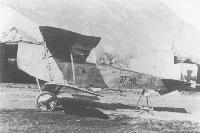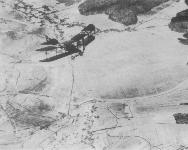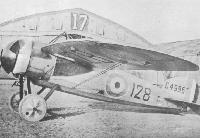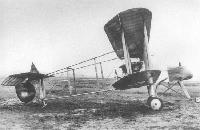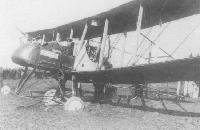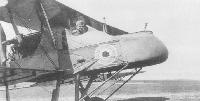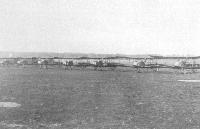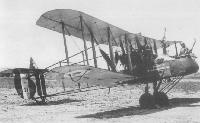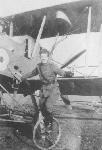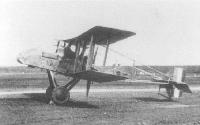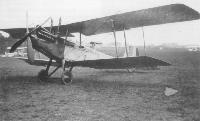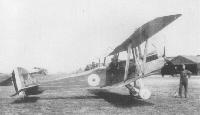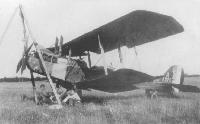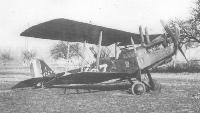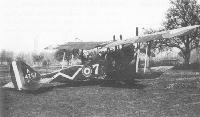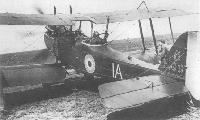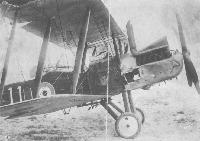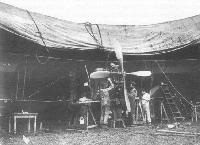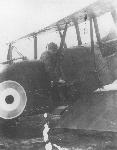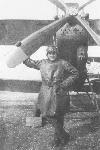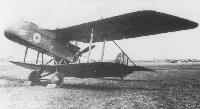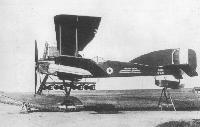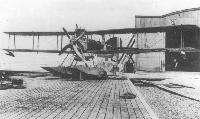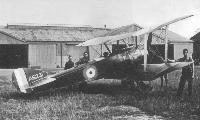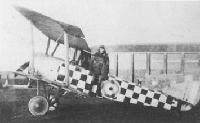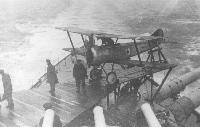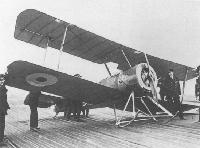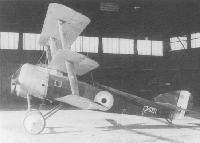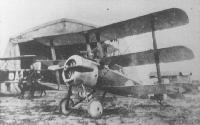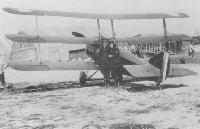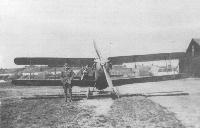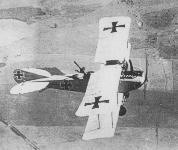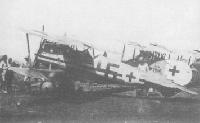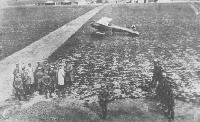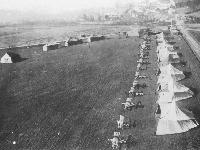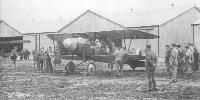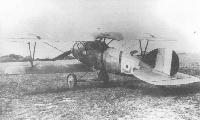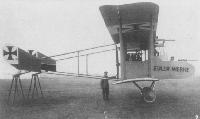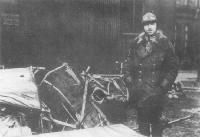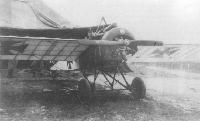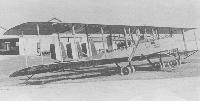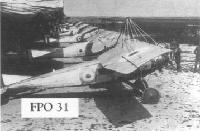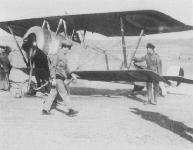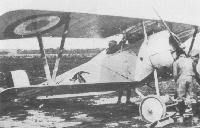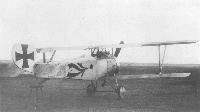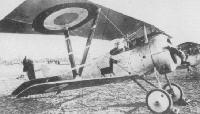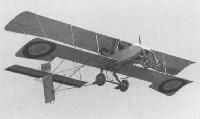Книги
Crowood
K.Delve
World War One in the Air
289
K.Delve - World War One in the Air /Crowood/
Albatros DIII of Austrian ace Godwin Brumowski showing the combat damage the aircraft received on 1 February 1918.
One of the early production Austrian Aviatik C I two seat reconnaissance machines, used on the Italian Front in late 1917. The serial, 37.40, just visible on the fuselage, follows the Austro-Hungarian practice of using the first 2-digit group to denote the production batch, while the last two numbers signify the individual aircraft's place within the batch, in this case the 40th machine. Unlike the German system, there is no indication of the year in which construction took place. Sadly, little hard performance data survives on the type itself.
The Austro-Hungarian units were a little better equipped but relied on German-supplied machines plus those that were licence-built in Austria. This Lohner B.II of Fliegerkompanie 6 is at Igalo in mid 1915.
The Germans and Austrians continued to dominate the air scene in the East with superior numbers ol better aircraft; types that were outclassed on the Western Front were often transferred to the East where they still proved effective. This Oeffag CI is over Galicia.
Checking out the aircraft ready for another sortie - an FK8 crew; good view of the Lewis gun with its simple ring-and-bead sight.
The FK8 had reasonable handling qualities and entered operational service in France with 35 Squadron in January 1917. The RFC prided itself on the determination with which it achieved its reconnaissance task - regardless ol the air opposition - and the FK8 played a leading role in this.
FK8 C8550 of 2 Squadron, a unit that operated the type from April 1917 to beyond the end of the war. It was while flying one ef these aircraft that Capt. F. West became involved in a dramatic air battle with German fighters and won the Victoria Cross.
The Armstrong Whitworth FK8 was designed as a two-seat reconnaissance-bomber. Powered by a 160hp Beardmore, the type had a speed ol just under 100mph (160kph) and a ceiling of 13.000ft (4.000m).
The Avro 504 series was another ot the great First World War designs with operational and, more especially, training significance. This scene at Baileul in 1915 shows '398 with 5 Squadron.
Avro 504 A8515 at Harling Road; the Avro 504 series saw limited operational employment but extensive use as training aircraft throughout the war.
The Avro 504J. with its 80hp Le Rhone or 100hp Gnome Monosoupape. entered service in the summer of 1917. With light yet powerful controls and capable of full aerobatics, the 504J was a superb training machine. This is a School of Special Flying example at Gosport.
The Avro 504 saw operational service in several roles early in World War One, and later became one ot the most important training types used by the RFC and later the RAF. This particular example served with the Robert Smith Barry School ot Special Flying at Gosport.
The Avro 504 series continued to be the most important of the training machines. This is Avro 504K F2623, one of those built by Sunbeam Motors.
Bristol Standard Boxkite No. 12a.
The basic nature of aeroplane design is evident in this Bristol Boxkite. The first powered aeroplane flight had taken place in 1903 but in the absence of military interest (and therefore investment) development was slow and left to private venture.
The basic nature of aeroplane design is evident in this Bristol Boxkite. The first powered aeroplane flight had taken place in 1903 but in the absence of military interest (and therefore investment) development was slow and left to private venture.
While RNAS personnel take to the grass and relax, the cockpit ot Bristol TB8 '1216 attracts some attention in this March 1915 scene at Eastchurch. Some 45 landplane versions of this aircraft were used by the RNAS, deliveries commencing in 1914.
Although the United States entered the war in April 1917, it was spring 1918 before any significant number of air units were deployed to France. Here personnel pose with a Scout С at Waddington, one of the training units to take USAS personnel.
Although the Bristol Scout D had made its first appearance in late 1915, it was the following year before they became operational with the RNAS. Some 80 Scouts Ds were ordered by the RNAS. a number of which were handed to the RFC during the summer.
Bristol Scout D '8988. This type, a development of the Scout С was destined to see extensive operational use in most theatres even though it was never truly successful.
During 1916 a number of new types were in their design and development stage: such was the Bristol F2A, another machine seen as a replacement for the BE2c. The type first flew in September 1916 and initial deliveries were made before the end of the year. 48 Squadron was the only fully equipped unit but the type led to the F2B - one of the best general-purpose aircraft of the war and one that had a lengthy post-war career.
Bristol Fighter of 11 Squadron; the unit re-equipped with this type in June 1917, giving up its FE2bs.
This F.2B (C-4814) of No 19 Squadron carries an early style of squadron recognition markings.
This F.2B (C-4814) of No 19 Squadron carries an early style of squadron recognition markings.
Bristol Fighter with Capt. Ross Smith and Lt. E.A. Munster of 1 (Australian) Squadron - this unit had operated Bristits in the Middle East from February 1918.
Among the specialist schools that had grown in importance by 1918 was the School of Aerial Warfare. This unit operated a wide range of types, such as this Bristol M1C seen at Marske in 1918.
One of three M-series designs from Bristol, the M1C was the only one to see real operational service - primarily in the Middle East and Macedonia. In Palestine 111 Squadron had three M1Bs on strength. This particular M1C was in use with the CFS.
'The de Havilland Army aeroplane' as this Royal Aircraft Factory FE.1 (for Farman Experimental) is titled on this photograph was the first product of Geoffrey de Havilland, a pusher type with a 45hp engine that he sold to the Government and that became the first aircraft from the new Royal Aircraft Factory. In 1911 it had passed its acceptance by flying for one hour without adjustment or repair.
Another of the pusher types, the DH1A with its 120hp Beardmore engine was superior to other contemporary fighters, but it did not see service in France. It was used in the Middle East and by the training organization in the Britain.
A 7845, a reconnaissance fighter version of the DH 4 used by No 202 Squadron, RAF. Note the ventral fairing required to house the long focal length camera.
The first operational unit with the DH4 was 55 Squadron, from January 1917. The unit moved to France in March and was soon heavily engaged on reconnaissance and bombing. In October the Squadron joined the newly formed 41st Wing as part of a new strategic bombing force to attack targets in Germany.
The RFC intensified its bombing campaign during 1917 with a variety of types taking part, such as this 55 Squadron DH4. The squadron had, in January, been the first DH4 unit and had moved to France in March.
The RNAS also used the DH4, the first unit being 2 (Naval) Squadron at St Pol in March 1917. This unit specialized in reconnaissance and artillery spotting tor naval monitors. The type also served with the RNAS in the Mediterranean theatre.
The aircraft salvage depot at St Omer repaired or cannibalized many aircraft. Seen here are two 57 Squadron DH4s whilst in the background are SE5a's and a Camel.
Among the types chosen to be licence-built in the United States was the DH4, although it was to be powered by a Liberty engine. Despite early problems with the match, the type went on to be used in the bomber role with some success. This Liberty-engined DH4 is 'somewhere in France' during 1918.
With its Presentation Inscription 'New South Wales No 15', DH5 A9197 was one of several such aircraft to serve with 68 Squadron (later to become 2 Squadron Australian Flying Corps). Production of the DH5 fighter commenced in early 1917 but it was the summer before any significant numbers were available.
The Airco DH6 was designed to be a reliable and straightforward trainer, with ease of manufacture and maintenance as the two prime considerations. Production began early in 1917 and very large numbers were ordered from a variety of contractors. Most of the reserve and training units used the type at some time. A9644 is shown with 23rd Training Wing at Scampton.
An armed DH6, with a good view of the gun mounting on the upper wing - C7835 at Fowlmere after Sgt. Thompson's 'quarrel with a cottage' in September 1918. Although primarily a training machine, the DH6 was also used for Home Defence and by a number of specialist units such as the School of Aerial Fighting.
By 1917 the RFC had identified the need for a specialist day bomber aircraft - especially in response to the growing degree of such activity by the Germans. The longer range of the proposed DH9 persuaded the Air Board to place orders for the type and by late 1917 it was under test at Martlesham. C2228 here was with 31 TS at Fowlmere in late 1918.
Based at Junction Station, with a detachment at Mudros, 144 Squadron was heavily engaged on operations against the Turks. Here DH9 C6297 has force-landed on return from a raid on 16 September 1918.
The Allied bombing offensive increased in scale and effectiveness from the summer of 1918; the formation of the Independent Air Force (more usually known simply as the Independent Force) created an impressive strategic bombing arm with its own fighter units. The DH9, despite its limitations, was one of the most numerous of bomber types in service at the end of the war - some 1,866 being on strength in October.
Marked with its serial number in black on the rear fuselage and on the fin, D1001 was the first machine to be built by the National Aircraft Factory No 2 at Heaton Chapel, near Stockport, Cheshire
Marked with its serial number in black on the rear fuselage and on the fin, D1001 was the first machine to be built by the National Aircraft Factory No 2 at Heaton Chapel, near Stockport, Cheshire
Lt. Lawson Reason with DH9 E619 of 98 Squadron; the unit moved to France in April 1918 and flew its first bombing missions on 9 April.
The DH9 entered service with 41 Wing in April 1918 (99 and 104 Squadrons) for the strategic bombing offensive; the RAF planned a day and night offensive against targets in Germany but the squadrons were frequently called upon to support the land battle.
The new DH9 day bomber was well into its testing period by autumn 1917 and despite a number of problems was put into large-scale production, reaching operational service in the spring of 1918.
Good view of the DH9 front cockpit, with Capt. D.S. Glover in C6117. Armament was usually a single Vickers and single Lewis plus up to four 112lb (50kg) bombs.
Pensive and well wrapped up, the crew ol this 98 Squadron DH9 await the next mission; the observer is Lt. F.J. Keble.
The DH10 first flew in March 1918 but development was slow and the type was entering production just as the war ended.
DH9A E8553 was on charge with 155 Squadron, one of the new day bomber units formed for service in France; however, the war ended before the unit became operational.
Although over 800 Airco DH9As had been accepted by the RAF before the Armistice, only four Squadrons were fully operational. The type was developed for bomber-reconnaissance and showed great promise; indeed it had a good post-war career. F1019 was operational with 99 Squadron, one of the squadrons of the Independent Force.
Sopwith Baby - the type was designed as a scout-bomber to operate from seaplane carriers in the Mediterranean and around the UK. N1452, here, was delivered to Calshot in October.
Anti-submarine patrols were as important in the Mediterranean as they were around the UK and a number of specialist Flights were formed to perform these duties. Four such Flights (Nos. 360 to 363) were based at Calafrana, Malta, and in August 1918 joined to form 267 Squadron. Felixstowe F2a N4488 served with this unit.
The decision to develop a true strategic bombing capability led to a series of long-range heavy bombers. The HP 0/400 followed the HP 0/100 into production as the RAF developed its strategic bombing doctrine - capability.
An early 0/400, possibly one of the early 'hand-built' aircraft assembled at the Royal Aircraft Factory, showing the O/400's short engine nacelles.
Standard production Handley Page O/400 with Rolls-Royce Eagle engines.
An early 0/400, possibly one of the early 'hand-built' aircraft assembled at the Royal Aircraft Factory, showing the O/400's short engine nacelles.
Standard production Handley Page O/400 with Rolls-Royce Eagle engines.
Lt. Loftus of 100 Squadron in the front turret of an HP 0/400 in France, September 1918. The bomber was defended by five Lewis guns.
Martinsyde S.1 Scout '4250. This was one of the first single-seat scout (fighter) types to serve with the RFC and first appeared in early 1915 as air combat was becoming of increasing importance. Armed with a single Lewis gun on the upper wing, the S.1 was used only in small numbers and was not a great success.
The campaigns in the Middle East continued to include air participation, albeit still on a small scale but often with decisive results. This Martinsyde S1 ('4250) is pictured at an unknown airfield in Egypt where it was probably in use for training. However, the 30 Squadron detachment in Mesopotamia had used two of this type with some success and this aircraft may have been destined for the same unit.
The campaigns in the Middle East continued to include air participation, albeit still on a small scale but often with decisive results. This Martinsyde S1 ('4250) is pictured at an unknown airfield in Egypt where it was probably in use for training. However, the 30 Squadron detachment in Mesopotamia had used two of this type with some success and this aircraft may have been destined for the same unit.
Martinsyde 'Elephant' A3988 at Salonica, possibly a 14 Squadron machine; the Squadron had been operating in the Middle East since November 1915, with detachments in Palestine, the Western Desert and Arabia.
Martinsyde Elephants of 27 Squadron at Fienvillers in 1916. The Squadron had arrived in France in March, having formed with the Martinsyde G 100 at Hounslow Heath the previous November, as a scout Squadron. With a speed of almost 90mph (145kph) and good manoeuvrability, the Martinsydes were effective when they first entered service.
Prototype Port Grain Griffin, one of a number of designs in 1918 from the Port Victoria design staff and based upon the Sopwith Baby. Only seven production aircraft followed and they saw very little service.
The Royal Aircraft Factory's role included all aspects of aeroplane design and their operational employment; this trials role was to be of great importance to British military development. Here, BE2a '601 is undergoing investigations into aircraft stability, hence the two small fins on the upper wing.
The BE2c was the definitive version of the BE2 series by the outbreak of war; it was a type that saw distinguished service in the early months. This example is seen with 2 Squadron at Netheravon in June 1914.
Allonville and BE2c '1779 of 4 Squadron RFC. The Squadron moved to this airfield in November 1915 and stayed there until February 1916.
BE2c '2026 of 12 Squadron, RFC. This was one of a number of units to use the type operationally on the Western Front - indeed, a BE2c of 2 Squadron was the first British aeroplane to land in France when the RFC deployed in support of the British Expeditionary Force.
16 Squadron formed at St Omer in February 1915 during one of the RFC s expansion periods, and was soon heavily engaged on reconnaissance work using a variety of aircraft although, like most units, the BE2c was the main workhorse - indeed, this type remained in service with 16 Squadron until May 1917!
The same night that L33 fell, 23/24 September, another fell to the guns of 39 Squadron when Lt. Fred Sowrey destroyed the L32. Sowrey is seen here in the cockpit of BE2c '4112. 39 Squadron scored another victory on 1/2 October, when 2nd Lt. Wulfstan Tempest destroyed the L31. L34 was also shot down the same night.
A unique aircraft - the highest serial number issued to a British aircraft and an indication of the rapid increase in aircraft production. The RFC initially numbered its aircraft with three or four digits but when the number 10.000 was reached it had already been decided that the system would be unmanageable. Henceforth, aircraft would carry a serial letter and four numbers, giving far more available combinations. This particular BE2c was a Blackburn-built aircraft.
The Home Defence units were still equipped with a range of types, most of which were unable to deal with the new German bombers and super-Zeppelins. The BE2c was still on strength with a number of Squadrons - as here in 58 Squadron's hangar at Cramlington.
Although the BE2c was by mid 1916 outdated and vulnerable on the Western Front, its inherent stability well suited it for the task of Home Defence and when the RFC took over responsibility for this task from the RNAS it was the BE2c that formed the bulk of the defending fighters to counter the night raids by German Zeppelins. The first success came on the night of 2/3 September 1916 when William Leefe Robinson of 39 Squadron shot down the SL.11. Here the pilot poses in the cockpit of his BE2c - the object being held by the airmen is part of his aircraft that he damaged during the combat.
Good upper view of a 2 Squadron BE2c. This type remained in significant numbers on the Western Front during 1916 and was very vulnerable: losses were high as the performance of the aircraft was now grossly inferior to that of the enemy fighter types.
The BE2, powered by a 60 or 70hp Renault engine - French aero engines were to remain among the best designs throughout the war - carried out a number of military trials, even at one stage being fitted with floats for seaplane tests, and was ordered into production with various British aircraft companies. With its maximum speed of 70mph (110kph) and ceiling of 10.000ft (3.000m) it was on a par with the designs being developed in France and Germany.
A great many aircraft were forced to land behind enemy lines and often they had little more than engine damage. Here BE2c '2742 is seen with German markings after such an instance.
The two-seat BE2d had a maximum speed of just over 88mph (142kph) and a ceiling of 12,000ft (3,700m). The pilot sat in the front cockpit, amidst the woodwork of the struts, while the observer sat behind - with a somewhat better field of view. This particular aircraft, '2785, was with CFS at Upavon.
Although ungainly in appearance, the FE2b was reasonably effective when it first appeared operationally in early 1916: however, it was not the great success in the fighter-reconnaissance role that had been hoped.
The first FE2bs were delivered to 20 Squadron in December 1915 and the following month the unit moved to France. This two-seat pusher was ordered in large quantities from a variety of contractors and throughout 1916 was one of the most important aircraft on the RFC's operational strength. This particular aircraft, '6338, was a presentation aircraft - Ceylon No 3 - with 20 Squadron.
FE2b A5666 with the 160hp Beardmore engine. This engine gave even more trouble than the other fits - and it must be born in mind that many of the engines in use were not particularly reliable - and caused much adverse comment. The Fees generally proved inadequate as fighters but appeared at a time when there was little else: however, they soon found a new role as bombers as this role grew in importance throughout 1916.
The FE2b carried a variety of armament but the commonest arrangement was for two (sometimes three) Lewis guns, the mounts for which can be seen here. The rear mount allowed the observer to fire back over the wing.
The FE2d resulted from an attempt to re-equip the FE2b with a more powerful engine such as the 250hp Rolls-Royce. It was never truly a success but the type entered service on the Western Front and for Home Defence from mid 1916.
The Allied bombing offensive grew in intensity during the summer of 1918. FE2bs continued to act as night bombers; here is a 58 Squadron example - plus a unicycling pilot, possibly W.L. Hope.
High-altitude single-seat version of R.E.5 No. 380.
One of the many 1913 designs aimed at providing an effective reconnaissance and bomber aircraft. The RE5 was in essence an enlarged version of the RE1 and led to further designs that were somewhat more successful. This particular aircraft has been modified to single seat configuration in order to achieve a number of height records. In June 1914 the commanding officer of 6 Squadron, Maj. J.H.W. Becke, claimed to have reached 19.000ft (5,790m).
One of the many 1913 designs aimed at providing an effective reconnaissance and bomber aircraft. The RE5 was in essence an enlarged version of the RE1 and led to further designs that were somewhat more successful. This particular aircraft has been modified to single seat configuration in order to achieve a number of height records. In June 1914 the commanding officer of 6 Squadron, Maj. J.H.W. Becke, claimed to have reached 19.000ft (5,790m).
Powered by a 110hp Gnome Monosoupape, the FE8 was employed as a single-seat fighter on the Western Front from summer 1916 to early 1917 but its speed of 80mph (130kph) and single Lewis gun meant that it was hopelessly outclassed. The type also served with Reserve Squadrons in the UK as here with 6401 with 10 Reserve Squadron at Joyce Green.
RE7 '2194 with 35 Reserve Squadron at Northolt in 1917; this aircraft was one of a batch of 50 built by the Coventry Ordnance Works.
The RE7 was designed as a two-seat reconnaissance/bomber and initial contracts had been issued in 1915. However, it was in January 1916 that the first fully equipped unit, 21 Squadron, deployed to France. The type had serious shortcomings and only two operational squadrons used it in France.
Even the famous Zeppelin-killing 39 Squadron was having to manage with outdated equipment: note the black-painted BE12 in the hangar behind the pilot group at North Weald.
BE12b of 76 Squadron, another of the Home Defence units that operated the type for two years from 1916. The pilot was Lt. Ranald MacDonald. The Home Defence organization expanded rapidly from late 1916 although it was equipped with BE2 and BE12 variants, which were soon outclassed. The euphoria over 39 Squadron's string of victories in late 1916 soon gave way to growing frustration.
Capt. Hadoi airborne in a BE12b of 50 Squadron. The Squadron used the type from May 1916 to June 1918, although from 1917 it was supplemented with other types such as the RE8 and Sopwith Pup.
BE12a A4040 crashed behind enemy lines killing the pilot. His body is shown in another photo from this sequence of pictures that were 'liberated' from a Bulgarian trench. Note the twin guns mounted on the upper wing.
Aircraft losses were due not only to enemy action; Indeed, most losses were in accidents or, as here, 'natural causes'. These five BE12s of 21 Squadron were wrecked within five days of their delivery to the Squadron at Boisdingem when the hangar was destroyed in a freak storm in autumn 1916'.
The BE2c was usually flown as a single-seater by the Home Defence units in an effort to improve its performance: it was self-evident therefore that the BE12 would also find its way to the Home Defence units. This Le Prieur equipped BE12a served with 50 Squadron in this role.
The BE2e was, like other BE2 variants, extensively used for trials and training duties as well as operationally. Its basic flying characteristics, reliability and rugged nature made it a good training machine. This particular example, C7133, is seen with 31 Training Squadron at Wyton in May 1918.
The BE2 series, as with this BE2e, soldiered on in the Middle East, this particular example being the first BE2e actually constructed in Egypt.
1918 and BE2 variants were still in regular use with training units. A1350 of 51 TS is little more than a pile of wood and wire after this crash on 6 January 1918.
Work on the RE8 general purpose two-seater to replace the BE2c began in late 1915 and the prototype (7996) first flew in June 1916; the type entered service with 52 Squadron in November.
RE8 A3570 was a Daimler-built example of this widely used and reasonably effective type - some 2.262 RE8s were built.
Recovery work on RE8 A3570 at Wyton in May 1917; the tripod lifting tackle was both easy to transport and ettective.
RE8 of 3 Squadron AC at Bailleul, 30 November 1917. Note the Presentation Aircraft inscription on the fuselage of A3662.
Atmospheric shot of a Daimler-built R.E.8 B5106 at Vert Galand in May 1918 prepares to take off, with two mechanics assisting in manoeuvring. Note the cut-out in the lower wing roots to give the pilot a better view of the ground below. Over 2,200 of this type served with the RFC from November 1916 to the end of the war. During this final year of conflict they were still heavily employed but with Allied air superiority, except at certain times, they were able to carry our their work at an acceptable' loss rate.
Artillery co-operation was one of the most dangerous of roles; this 21 Squadron RE8 was involved in a shoot over Ypres in October when a 'shell passed through the aircraft'.
Excellent field hangar shot of ground crew working on an RE8 of 3 Squadron AFC, possibly at Bailleul.
From October 1917, 63 Squadron operated the RE8 from Basra and various detachments at other airfields.
Demonstrating the operation of a camera fitted to the RE8. The primary role of the aircraft was reconnaissance and during its operational career many thousands of plates were exposed - a vital contribution to Allied military planning.
Capt. W.E. Johns, author of the Biggles novels, in front of an RE8. He was shot down in DH4 F5712 ol 55 Squadron on 16 September 1918.
Major Frank Gooden, a Farnborough test pilot, in the cockpit of the first S.E.5, Folland's renowned World War I fighter.
New fighters under design in 1916 began to make their appearance: SE5 prototype A4561 had first flown in November 1916 and the following month was in France for pilot evaluation. It was generally well liked but there were problems, some of which had not been resolved when the first production aircraft were delivered in March 1917.
New fighters under design in 1916 began to make their appearance: SE5 prototype A4561 had first flown in November 1916 and the following month was in France for pilot evaluation. It was generally well liked but there were problems, some of which had not been resolved when the first production aircraft were delivered in March 1917.
56 Squadron SE5 A4863 at London Colney in April 1917, before leaving for France. As the first SE5 unit, 56 Squadron received aircraft from March 1917 and the following month moved to France.
Aircraft of the second SE5 production batch were given the larger windscreen - giving a semi-enclosed cockpit - but this was not liked by the operational pilots as it was thought to be too restrictive. A8904 is see here at Farnborough in April 1917; it subsequently became operational with 56 Squadron and flew its first combat patrol on May 6.
An unidentified S.E.5a with the four-bladed propeller usually fitted to machines powered by the 200hp geared Hispano-Suiza engine. The aeroplanes in the background are B.E.2es.
As well as extensive operational service, the SE5a was used by a number ot training units - this particular colourful example is probably an instructor's aircraft.
Dispersal shot of 6 Squadron AFC with SE5a at Minchampton in spring 1918. All four of the last Australian Squadrons (Nos. 5 to 8) were still working up to operational status during 1918 and did not see active service in France.
143 Squadron SE5a D5995 at Throwley; the Squadron operated the type from March to August 1918 when they were replaced by Camels.
The SE5a was one of the classic British fighters and was a direct follow-on from the SES; the type entered service in the spring of 1917 and, despite a number of engine problems, was an immediate success.
The shortage of aircraft for the growing USAS in France led to the purchase of British and French types, including a batch of fifty SE5a fighters - including F8083 shown here.
Seen at Hounslow sometime in 1917 is FE9 A4818; it has extensive graffiti around the forward fuselage but this is unfortunately unreadable. Note the long overhang to the top wing and the huge aileron balance areas. Designed as a two-seat fighter-reconnaissance replacement far the FE2b, the type arrived in France in the summer of 1917 for trials but in the event was only produced in limited numbers.
The RNAS had from the very first days of the war adopted an offensive strategy for their land-based aeroplanes and seaplanes. This bombed-up Short 184 seaplane was a type that entered service in 1915 and remained in use throughout the war.
Standard Short-built Short Type 184 No 8076 with 240hp Sunbeam engine, illustrating the manner of carrying the bomb load of four 100/112 lb bombs on a centreline beam. Unlike the early examples, this aircraft has double-acting ailerons.
Standard Short-built Short Type 184 No 8076 with 240hp Sunbeam engine, illustrating the manner of carrying the bomb load of four 100/112 lb bombs on a centreline beam. Unlike the early examples, this aircraft has double-acting ailerons.
Some of the first Short 184s went aboard the seaplane carrier Ben-my-Chree for the Dardanelles campaign. In August 1915 one of these was used by Flt. Cdr. Edmonds to sink a Turkish ship with a torpedo - the first such success for this weapon when delivered by an aeroplane.
The Sopwith Tabloid, serial no 394 seen here, typifies the best of the RNAS's front-line equipment at the start of the war. Powered by a 100hp Gnome and capable of a top level speed of 92mph at sea level, the single seater was able to carry a couple of 20lb bombs and as such was to become the first British aircraft to fly a significant strike against German forces, when, on 8 October 1914, a bomb dropped from Lt R.L.G. Manx's Tabloid, serial no 168, destroyed the Zeppelin Z IX in its shed at Dusseldorf. Once mighty Zeppelin Z IX's hulk smouldering in its lair following the daring raid by Marix. Flying his No I Naval Wing machine from an already embattled Antwerp, Marix's Tabloid was damaged during the attack, resulting in the pilot having to force land twenty miles short of his base, completing his journey by borrowed bicycle. Between April 1914 and May 1915, the RNAS took delivery of 39 Tabloids.
Very rare shot of a Sopwith Baby firing Le Prieur rockets at the Isle of Grain. Despite doubts (and lack of operational success) with this weapon, a wide range of aircraft were so equipped.
43 Squadron took its Sopwith 1 1/2 Strutters to France in January for fighter-reconnaissance duties, operating initially from Treizennes. This view of A1052 is either at that field or at Auchel, where the Squadron moved in May.
With the growth of the daylight bombing threat, fighter types joined the Home Defence force - as here with Sopwith 1 1/2 Strutter A8274 in service with 37 Squadron in mid 1917. The Squadron occupied four LGs in Essex, the prime area over which the Gothas flew to reach their targets.
Transfer of aircraft was not all one way, and several types were licence built. Nieuports and Spads, for example, being built in England while the Sopwith 114 Strutter was built in France as the 1A2.
Other Allied types were also in use over the Italian Front - this Sopwith 1 1/2 Strutter was captured by the Austrians and is here being prepared for a flight.
The RNAS also acquired the Camel. This aircraft, N6336, was delivered to Martlesham for engine tests in May 1917 as it was one of a small batch with a 150hp BR.1. It was later operational with a number of units until, in October 1917, it became a Ground Instructional airframe.
It was not only the dedicated Home Defence Squadrons that took part in the battle; other units sent aircraft up. On 22 August Flt. Lt. A. Brandon was flying Camel B3834, from the War Flight at Manston, when he attacked a number of Gothas; of the 10 aircraft on the raid, three were shot down by anti-aircraft and aeroplane attacks, and Brandon was involved in at least one of these victories. The 'Wonga Bonga' graphic refers to the noise that the Gotha engines made.
With their Squadron markings prominent on the fuselage these are Camels of 45 Squadron. B5152 was with the Squadron for a few weeks from early October 1917 but was shot down on 26 October, 2nd Lt. E. Smith being taken prisoner. In some records B3925 does not appear as having served with the unit - although this photograph is fairly unequivocal.
The RNAS and RFC made great use of the Camel from mid 1917 to the end of the war. B6299 served with 10 Squadron RNAS in late 1917 and scored a number ol victories; it subsequently returned to the UK to join 207 Training Depot Station at Chingford.
Maj. W.G. Barker poses with Camel B6313 of 139 Squadron. The squadron had formed at Villaveria, Italy in July 1918 and this was the only Camel in an otherwise Bristol Fighter-equipped unit.
Aircraft production in Britain was by early 1918 efficient and large numbers of aircraft were being made available from a wide range of companies. Ruston Proctor built well over 1.000 Camels; here D8185 is seen at Monks Road, Lincoln on 1 June 1918 as part of a recruitment procession - the women being known as the 'Ruston Munitionettes'. The first unit for this particular aircraft was 471 Flight at Walmer.
The Sopwith Camel is regarded by many as the finest fighter of the First World War; F6394 was from one of the last Boulton-Paul batches of Camels and was delivered to Martlesham Heath in September 1918.
Camel of 66 Squadron. With its good all-round performance and twin Vickers guns, the Camel was a potent fighter in the hands of experienced pilots.
65 Squadron pilots with one of their Sopwith Camels; the Squadron had acquired Camels in October as they departed tor France.
Aircrew of 208 Squadron pose with their Camels: the Squadron had formed at Dunkirk from the old 8 Squadron RNAS upon the formation of the Royal Air Force.
The deleted aircraft serials on this line of 73 Squadron Camels are an attempt to censor the picture.
226 Squadron Camels at Taranto; the unit was formed from a number of RNAS Flights in April 1918 and was involved in a variety of roles over and around the Adriatic.
A number of Allied Squadrons deployed to Italy to help bolster the air assets during periods when the Austrians were dominant. This photograph is captioned 'Italy 1918 and a line-up of 45 Squadron camels'. The unit moved to Italy in December 1917 and stayed there until the following September but this may have been taken in France before their departure.
50 Squadron received its first Camels in May 1918 as part of an effort to boost the Home Defence squadrons' capabilities to combat day and night raiders.
Camel B7227 of 10 Squadron RNAS having come to grief behind the German lines after being attacked and shot down on June 21 by four Fokker DVIIs; 2nd Lt. R.G. Carr was taken prisoner.
Colourful Sopwith Pup B7575 in service with 26 TDS; many instructors' aircraft acquired highly decorative schemes!
The need to get fighters to sea and the slow development of true aircraft carriers, led to a number of ship modifications: here Sopwith Pup N6459 sits on a turret platform aboard HMS Repulse in October 1917.
Its skid-type undercarriage having collapsed, this Pup sits on what is possibly HMS Argus. Skid-equipped Pups were certainly aboard HMS Furious in early 1918 and by mid year some ten of these aircraft were operational with various carriers.
1917 saw the appearance ot a number of triplane designs; the Sopwith Triplane was adopted by the RNAS as its superb manoeuvrability and top speed of 113mph (182kph) made it an excellent fighter - even though most were armed only with a single Vickers gun. N5351, a Clayton & Shuttleworth example, is seen here at Cranwell in February 1917 but it was soon operational with 8 Squadron RNAS.
Another of the Sopwith Triplane users, 10 Squadron RNAS. This squadron had formed at St Pol in February 1917, initially with the Nieuport 12.
The French accepted a limited number of Sopwith Triplanes, this example being with the Naval Fighter Flight at St Pol in 1917.
A Sopwith Camel modified with cut-away in the centre section of the upper wing to allow an upward-firing gun to be fitted. This is possibly N6643, one of 50 Sopwith 2F1 'ships Camels' delivered in early 1918.
Despite the early success of an air-launched torpedo, development of this capability was slow; the Sopwith Cuckoo was designed for the role but did not make an appearance until 1918. This particular aircraft, N6971, was an Arab-powered Blackburn-built example with enlarged rudder that entered service in August 1918, going to 201 TOS at East Fortune.
Sopwith Snipe E6274 was one of a batch of 400 produced by Boulton-Paul; it is seen here at Freiston sometime in 1918. Large-scale production orders were issued in March 1918, the type having been selected as a fighter following a Martlesham test earlier in the year.
43 Squadron Snipe with an underfuselage bomb carrier. The Snipe was powered by the 230hp Bentley BR2 and remained in service long after the Armistice.
By early 1916 the FB5 Gunbus was completely outclassed, causing Trenchard to comment: it is essential that these machines be replaced by something better at an early date.
Deliveries of the Vickers FB5 Gunbus began in December 1914, the type starting its operational career with 5 Squadron in early 1915. This was an attempt to provide an aeroplane armed with a machine gun for the Western Front, after it became apparent that aircraft would have to be armed in order to protect themselves and at the same time destroy the enemy. This particular aircraft, '5659, was at Joyce Green.
The only front-line unit to use the FB9 was 11 Squadron, which acquired the prototype in January 1916 for operational trials. This was a standard procedure with new aircraft types being used by selected squadrons in action to assess the true potential of the type. The FB9 seemed promising despite a poor gun mounting and the type was put into production; however, by July 1916 the few that had reached operational status were withdrawn.
F.B.14 running up for air test in 1916 from AID base then located at Farnborough; later the airframe was submitted to static structural testing at the Royal Aircraft Factory.
Designed as a two-seat fighter-reconnaissance aircraft, the FB14 looked a good design and was ordered into production off the drawing board. In the event. however, only six of these Vickers aircraft were allocated to the RFC (and ten to Home Defence in 1917). A686 is seen at Farnborough in 1916.
Designed as a two-seat fighter-reconnaissance aircraft, the FB14 looked a good design and was ordered into production off the drawing board. In the event. however, only six of these Vickers aircraft were allocated to the RFC (and ten to Home Defence in 1917). A686 is seen at Farnborough in 1916.
With a number of Spad-like features, the Vickers FB16 fighter was designed around the Hart radial engine, although following problems with this it was given a 150hp Hispano-Suiza and appeared as the FB.16D. Pilots such as James McCudden (in June 1917) were impressed: 'at 10.000ft it was 30 mph faster at least than anything I had yet flown.' However, this promising type was not put into production.
Two interesting views of the three-man AEG G III bomber that made its prototype debut in December 1916. Only built in small numbers, the twin 220hp Mercedes D IV powered machine carried a maximum bomb load of 770lb and had a top level speed of 103mph at sea level. Armed with two flexibly-mounted 7.92mm Parabellums, the G III was delivered to KG I during the spring of 1917. The image shows a newly arrived, pristine-looking G III being inspected by unit personnel.
The AEG GIII was likewise only produced in small numbers and was operational by spring 1916. Among other users was Kagohl 1, which employed the type during their involvement on the Macedonian Front. The aircraft was powered by two 220hp Mercedes DIV engines, which gave it a very respectable 98mph (158kph) speed.
The AGO CII was designed as a reconnaissance aircraft and appeared in late 1915. The sleek aerodynamic shape and twin-boom configuration made the type quite distinctive.
Albatros Type В at Wilhelmshafen in service with II. Seeflieger Abteilung, probably 1915. The German seaplanes were aggressively operated over the North Sea and carried out a wide range of roles, frequently in conjunction with either submarine or surface vessel operations.
Summer 1917 and crews pose with an Albatros CI; although the type had entered service in 1915 as a general-purpose aircraft it had by 1917 been relegated to other uses. A dual-control trainer variant was also in use.
Albatros CIIIs entered service on the Western Front in the winter of 1916; the type was built in large numbers by a variety of manufacturers. Powered by either a 150hp Benz BzIII or 160hp Mercedes DIII it had a top speed of 87.5mph (141kph).
Staffel 39 Albatros CVI at Artemps in 1916. Although produced in only limited numbers this was an effective reconnaissance type. In essence it was a DIII variant with a 180hp Argus Aslll engine.
A well wrapped-up crew in their Albatros CVI - Lt. Bassenge and Uffz. Flbel. Open-air cockpits, winter conditions and high flying combined to make aircraft in the First World War quite uncomfortable!
This angle clearly shows the upper wing cut-out on this Albatros DIII to improve the pilot's forward and upward view and the smooth, semi-monocoque plywood fuselage.
An Albatros DIII in Palestine. The Germans provided air assets to support the Turks in various areas, but the level of air involvement was generally small.
Albatros DIII having been recovered by the Allies and In the process of being repaired. The type began its combat career over the Western Front in early 1917 and by the spring was taking an increasing toll of Allied aircraft. The term 'Albatros Nieuport' refers to its Nieuport-like sesquiplane wing layout.
Gen. Ludendorff visited Courtrai on 18 August 1917 to review Jasta 2; one of the unit's Albatros DVs is in the background.
A number of captured German aircraft spent time with training and trials units; here an Albatros is at Gosport with one of the most famous of all exponents of flying training, Maj. R.R. Smith-Barry.
The Albatros DV was a follow-on to the successful DIII in response to the improvements in Allied fighter types; it entered service in May 1917 and by mid summer was appearing in increasing numbers. This captured example is formerly 1102/17 and is seen at Lympne in August 1917.
It was a similar story in most countries and the similarity of the above design and this from Aviatik AG in Germany is obvious.
The Aviatik BII had been phased out of operational use but was still in use with training schools - as shown by the 'S' on the airframe of this example.
The German C-type aeroplanes of 1915 were designed to perform both reconnaissance and escort (limited fighter) roles. It became one of the best-known products of the Automobil und Aviatik Company and was built in appreciable numbers.
The Aviatik CI was still in use during 1916 but was outclassed by the latest British and French fighters, leading to increased losses and a reluctance to cross the Allied lines on reconnaissance. This particular example, as can be seen from the rudder markings, is a captured aircraft.
The Aviatik CIX entered tests in the first part of 1918. Powered by a 200hp Benz IV the aircraft had a top speed of 100mph (160kph) and a ceiling of 14,760ft (4.500m) - quite inadequate for the period.
The DFW CV was used in large numbers from 1916 to the end of the war in a variety of roles. Note the distinctive 'fish tail'.
Euler C-type under test in mid 1916: note the armament of two parabellum machine guns. This, along with the Spandau, was a very effective aerial weapon and a success for German machine gun technology.
Intended for training use, the Euler Dr4 was put forward in 1916 and was one of the only types to have side-by-side seating for the crew.
The capture of Garros and his 'gun system' led to the development by Fokker of his series of monoplanes armed with a Spandau firing through the propeller disc using an interrupter gear, in this case an E.III.
Fokker M.14V (E.III) 401/15 flown by Lieutenant Von Zastrow. The aircraft carried no compass and there was an unknown device attached to the cockpit side.
Fokker M.14V (E.III) 401/15 flown by Lieutenant Von Zastrow. The aircraft carried no compass and there was an unknown device attached to the cockpit side.
Another Fokker E.III showing the neat lines of this aircraft and the exceptional field of view for the pilot; one of the criticisms of the design was that the pilot sat on top' and was the danger of head injury in the event of the aircraft flipping over in landing. Some 150 of the Oberursel-powered EIIIs were built and their impact on the air war was far in excess of their actual numbers. This example was captured by the French and subjected to a rigorous technical examination; the results were published in the magazine L'Aerophile in 1916.
The Fokker Eindeckers were a favourite mount of Max Immelmann, perhaps the greatest of the early air fighting aces.
Gen. von Hoeppner visiting Schleissheim in mid 1917: three Fokker DVs and one Fokker DIII are in the line.
Gen. von Hoeppner visiting Schleissheim in mid 1917: three Fokker DVs and one Fokker DIII are in the line.
Outright winner of the fighter competition was the Fokker DVII; the type has been assessed as one of the best three fighters of the war and it certainly caused the Allies many problems during 1918.
Friedrichshafen developed a superb series of seaplanes during the war. The FF29, as here, was produced from late 1914 for coastal patrol duties.
The Halberstadt CLII was one of the types built in 1917 for Schutzstaffeln (escort flights) - a two-seat fighter escort armed with one or two Spandaus plus a parabellum for the observer.
A direct follow-on from the DII, the Halberstadt DIII performed reasonably well during 1916; it served on into spring 1917 pending delivery of new single-seat scout deliveries but by then its speed of 90mph (145kph) and single Spandau were simply not adequate.
The battles around the Isonzo were fierce both on the ground and in the air; a line-up of Hansa-Brandenburg CIs of Fliegerkompanie 101G at Ivacca, late 1917.
Прототип "Юнкерс" J 10
An aircraft of advanced appearance, the Junkers J8 prototype of January 1918 incorporated many new features - not least the all-metal construction. In due course it gave rise to the J10, which subsequently entered production as the CLI.
An aircraft of advanced appearance, the Junkers J8 prototype of January 1918 incorporated many new features - not least the all-metal construction. In due course it gave rise to the J10, which subsequently entered production as the CLI.
The LFG Roland CII, of which several hundred were built, entered service in early 1916 as a reconnaissance aircraft but was also used as an escort fighter.
A good illustration of the restricted view of pilots in many of these early designs is given by this LVG CII. However, this type was one of the first to be armed with a forward-firing Spandau machine gun and a parabellum gun for the observer. The aircraft entered service late in 1915 for a variety of roles.
In British markings, this LVG CII was photographed by Capt. D.S. Glover when it was under test with the RFC. The CII had first appeared in late 1915 and by 1916 was in widespread use.
The Pfalz E.I had its origins as an unarmed reconnaissance aircraft but with the advent of the Fokker synchronization gear in 1915 it appeared, like the Fokker E.I (and E.III) with a forward-firing Spandau.
The Pfalz DIII reached the Bavarian units at the front in the autumn of 1917. An Allied test on an aircraft captured the following February praised most aspects of this lighter.
Pfalz DIII 1330/17.
Pfalz DIII 1330/17.
Pfalz DIII 1370/17 (which acquired G 110 as its captured serial). The aircraft belonged to Jasta 10 and was shot down by a 35 Squadron aircraft on 27 December 1917. It is seen here at Estrees-aux-Chausee.
Postcard of a flyer in front of an early Rumpler Taube. Various companies produced Taube designs, a number of which saw operational service, but it is the Rumpler version that is best remembered.
The Rumpler G.1 went into production in 1915 as a reconnaissance/bomber but only was used in small numbers by the Germans.
The German strategic bombing campaign against London continued into 1918. Zeppelin-Staaken RXV R47 was one of three of this variant to see operational service, the first, R46, having been delivered in August 1917.
The Ansaldo SVA. The SVA series ot reconnaissance aircraft were among the best of the war, from the SVA 4 and SVA 5 of 1917 through to the two-seat SVA 9 and SVA 10. This aircraft is seen at Hounslow.
Caproni bombers were among the first of the true strategic aircraft and, in various forms, were operational throughout the war with a number of Allied air forces.
"Помилио РЕ" с турельным "Льюисом" и нестандартной установкой курсового пулемета "Ревелли" над верхним крылом
Pomilio at Campodi Marcon; this was the second variant with a 270hp Fiat D engine. The Pomilio series was built in large numbers during 1917 and 1918 with some 30 plus squadrons being equipped.
Pomilio at Campodi Marcon; this was the second variant with a 270hp Fiat D engine. The Pomilio series was built in large numbers during 1917 and 1918 with some 30 plus squadrons being equipped.
By 1917 the Italians had an increasing number of their own designs entering service; such as this SIA 7B reconnaissance aircraft from Societa Italiana Aviazione, a subsidiary of FIAT. The type developed structural problems and was withdrawn in July 1918. This aircraft, '5870, was photographed at Lympne having flown from Turin to Hounslow on a liaison visit.
Sikorskii Ilya Muromets. The IM name was given to all of Sikorskii's four-engined military aircrtaft, various bomber types of which served throughout the War.
No 4 School of Military Aeronautics formed in Canada during the first half of 1917 to increase the training output. Curtiss JN-4 C245 has suffered the fate of many a training aircraft - but fortunately the crews often escaped without injury.
The training organizations of all the belligerents had to expand to meet the requirements of the front-line units; suitable aircraft were often in short supply. The RNAS and RFC made use of Curtiss JN-4 Jennies such as '8820 seen here at Redcar in September 1916 to supplement its training types.
The Bleriot XI was built in five principal versions and was in military use from 1910 - equipping a number of French squadrons by the outbreak of War. It also served with the Italian and British (as here) air arms.
Of the other early designs, the Bleriot XI was of particular note and was yet another French type to be used by the British. It was also a long-lived type serving on into 1916 (as with this RNAS example that was delivered in January 1916 by which time they were primarily used for training).
A number of aircraft designs were acquired and tested in the period from 1912 to 1914. One such under British test - the Royal Naval Air Service having an interest in seaplane types - was the Borel monoplane seaplane, which was taken on strength at Calshot in July 1913 and flown by Sub. Lt. J.L. Travers (as serial 83). It was kept on strength until late the following year.
Самолет мог стоять в горизонтальном положении, опираясь на носовое колесо, только при наличии экипажа в кабинах. "Пустой" самолет опирался на хвостовой костыль.
The RNAS operated a small number of Breguet pushers with 5 Wing from spring 1916. Despite its fairly high-powered 225hp Sunbeam Mohawk engine, the aircraft could only achieve 86mph (138kph) and a ceiling of 12.140ft (3,700m).
The RNAS operated a small number of Breguet pushers with 5 Wing from spring 1916. Despite its fairly high-powered 225hp Sunbeam Mohawk engine, the aircraft could only achieve 86mph (138kph) and a ceiling of 12.140ft (3,700m).
The Breguet 14 A2 reconnaissance aircraft was powered by a 300hp Renault engine; the prototype first flew in November 1918 and the type went into large-scale production.
Breguet 14 A2 reconnaissance machine; over 5.500 Breguet 14s in reconnaissance and bomber variants had been built by the end of the war and production continued into the 1920s.
The Breguet 14 B2 prototype was introduced in the French forces in April 1917 as a bigger-winged variant of the successful 14 A2. The bomber variant was given racks under the wings for 32 small-calibre bombs.
Breguet 14 of the 96th Squadron being loaded with bombs at Amanty. 29 July 1918. Maj. J.L. Dunsworth is on the right.
A robust and reliable bomber, the Caudron R4 was somewhat lacking in performance and was eventually replaced by the RXI.
Another of the common French designs in this early period was the Deperdussin series of monoplanes from the Armand Deperdussin works in France and its British counterpart. These tractor type monoplanes, however, acquired a poor reputation with a number of fatal crashes - the net result of which was, for the British, a ban on monoplane designs.
While the BE2 was the main tractor type in British service, the Farmans were the prime pusher types, as shown here in this line up of Henri-Farmans including '274, '351, and 708 (with BE2s in the background). The advantage with this design was that the observer in the nose had an exceptional all-round view.
Workshops at the Central Flying School, one ot the elements established when the British created their military air arms in 1912. The rudder to the right shows aircraft 412, a Henri-Farman (formerly serial No 208), one of two Henri-Farmans acquired by the Royal Flying Corps when it formed in 1912. Like so many of the early aeroplanes used by European nations these were of French manufacture.
Farman F.40, often known as the Horace Farman, saw limited service with 5 Wing RNAS and was often, as here, armed with Le Prieur rockets on the inter-plane struts.
One of the major problems for all the air forces was that of ground fire - and the fact that troops tried to shoot at any and every aeroplane! National markings were painted on aircraft to show ground and air forces whose side you were on. The British at first adopted a Union Flag but as the central cross element was mistaken for the cross used by the Germans, they soon decided to adopt a roundel similar to that used by the French but with reversed colours (the red in the centre). This Maurice-Farman Shorthorn clearly shows a roundel on the upper wing - note also how transparent the fabric is.
The German submarines were a major problem for Allied shipping around the UK and the RNAS's flying boats, such as this FBA, flew thousands of hours on antisubmarine patrols. The FBA (Franco-British Aviation) was a small two-seat aircraft of which some 128 were used by the RNAS.
Macchi-built Hanriot HD1 fighters; despite producing some excellent bombers and reconnaissance aircraft, the Italians continued to rely on licence-building fighters.
Maurice-Farman Longhorn N5729, one of a batch of 30 built by the Brush Electrical Engineering Company, with an 80hp Renault engine. Like most of the Farmans, this type served primarily as a trainer and remained in use until 1918.
Although the Maurice-Farmans, this being an S.7 Longhorn variant, were on operational strength in mid 1914 they saw only limited operational service; a number were given machine gun armament as part of early trials into such weapons on aircraft. The tractor design meant that such a weapon could be satisfactorily mounted at the front but the additional weight reduced the already barely adequate performance.
The Russian air elements at the outbreak of the war were very weak and relied almost entirely on foreign, particularly French, types. This Maurice-Farman S.11F was in service with the Russian Navy; it was in essence a floatplane version of the Shorthorn with a 70hp Renault engine.
The other Farman variant was the Maurice-Farman, shown here in the S.11 Shorthorn version with 2 Squadron RNAS. Maximum speed was only 72mph (116kph) but endurance was almost four hours and the type was, despite its appearance, fairly rugged.
Egypt was the main location for the various training schools within the Middle East: this Maurice-Farman was with the School of Aerial Gunnery - until written off when a BE2c landed on it!
French Morane monoplane with an 80hp Gnome engine. Used by both British and French squadrons, the Morane monoplanes were among the first types to be equipped with a forward-firing machine gun.
The similarity between the Morane H and the German monoplanes it inspired is obvious in this picture of a captured H. Note the manufacturer's badge on the cowling.
Morane Parasol of 1914 vintage, the early type with slab-sided fuselage and small tailplane - in German hands.
The British continued to use French machines; here a Morane BB biplane in service with 60 Squadron in June 1916, one of four RFC units on the Western Front to operate the type.
The Morane-Saulnier 'parasol' series ot monoplanes saw extensive use with the French and British. Here is a line-up of mixed types - probably L and LAs - with 3 Squadron RFC in 1915. Their main tasks remained those of reconnaissance, including photography and artillery spotting.
The Morane-Saulnier Type A was designed in 1917 and over 1,200 of the type were built, the introduction to service being in September. However, it had only three months operational service before being withdrawn for training use on the grounds that the engine was unreliable and better types were becoming available.
The French Nieuport company established a reputation for developing a series of fighters that were among the leading designs of the day. This Nieuport 10 ('8517) served with 2 Squadron RNAS and was one of 50 such taken on charge from 1915.
Nieuport 11 established a good reputation and the basic Nieuport design characteristics began to appear in a number of aircraft; these are at Luxeuil in May 1916.
Following on from earlier Nieuports in RNAS service, the Nieuport 11 Bebe' is here as '3982 of 2 Squadron RNAS - part of 1 Wing at Dunkirk. The Bebe became operational with Escadrille N3 in January 1916 and was an immediate success.
Besides being used extensively by both the French and British forces, the Nieuport 11 was to provide the backbone of other Allied nations' fighter forces, including those of Belgium, Italy and Russia. Shown here is an Italian unit equipped with the type, which served as Italy's standard fighter from its initial deployment with them during the summer of 1916 to mid-1917. In the case of Italy, the Nieuport 11's role extended beyond its operational use, as 450 of these machines were produced under licence in Italy by Nieuport-Macchi. Thus, it could be said that this nimble little machine not only helped secure Italian skies, but played no small part in helping establish the country's future aeronautical industrial base.
The Macchi-built Nieuport 11, of which almost 650 were built under licence, was a standard fighter with the Italians up to the summer of 1917.
Following the Dardanelles fiasco, the Allies maintained an air presence on land and with seaplane carriers in the eastern Mediterranean. This Nieuport 12 ('8731) was at Mudros in November 1916.
The Nieuport squadrons played a vital role in wresting air superiority from the Germans around Verdun and over the French sectors south of the Somme. This Nieuport 17 served with Escadrille N3.
The Eastern Front remained very much a ground war although air operations did grow in importance during 1916; the Russians continued to rely on foreign aircraft, such as this Nieuport 17.
The Nieuport 17bis differed from the 17/23 (those two types being virtually indistinguishable) in its circular fuselage and the use of a Clerget engine in place of the normal 110hp Le Rhone.
A variety ot Allied aircrew posing in front of a Spad VII. The prototype of this great fighter first flew in April 1916 and it soon entered production. Designed by Louis Bechereau, this was without doubt one of the best fighters of the war.
The Spad VII with its 150 or 180hp Hispano-Suiza engine had a top speed of 119mph (192kph) and was yet another of the superb French fighter designs that appeared from mid 1916 onwards.
The Spad S.7C1 was used by fighter units until 1925.
The Spad S.7C1 was used by fighter units until 1925.
Among the French aces to establish a reputation on Nieuports and Spads was Charles Guynemer. Here he poses with a Spad VII in December 1916.
The French fighter units continued to use the Spads and Nieuports to good effect. These Spad VIIs are from SPA97.
Rugged and dependable, and rated amongst the top three fighters of the War, the Spad VII served on to the end ol the war.
The two-seat Spad XI was conceived as a reconnaissance-bomber but following its introduction in 1917 was not a great success. Nevertheless, it was delivered in large numbers and continued in use until mid 1918.
[Janes] Side View of a British two-seater Spad XI, captured by the germans. Developed from the Spad VII, it achieved 175 km.p.h. on a 235 h.p. Hispano-Suiza engine.
[Janes] Side View of a British two-seater Spad XI, captured by the germans. Developed from the Spad VII, it achieved 175 km.p.h. on a 235 h.p. Hispano-Suiza engine.
'Ace of aces' Rene Fonck who was credited with 75 victories by the end of the war; his first operational posting had been to Escadrille C47 (flying Caudrons) in June 1915 as a Corporal Pilot.
Spad XIII C.1. Powered by the geared 220hp Hispano, the Spad XIII was fast, but not as manoeuvrable as the Spad Vll.
The series of Voisin pusher-engined, two seaters initially entered service with the French prior to the war and through improvements continued to flow into service through to early 1918. The Voisin LA, or Type III, depicted here, entered service in early 1915 and used a 130hp Salmson-built Canton-Unne 9M. The Type III's top level speed was a modest 76mph at 6.560 feet. The machine carried a 460lb bombload over a range of 250 miles at a cruising speed of 59mph. By way of defence one Hotchkiss or one Lewis gun was mounted forward. Built in quantity, the Type III was used by France, Belgium, Russia and Britain's RNAS, an example of which is seen here, operating from the northeastern Aegean island of Imbros during the early summer of 1915.
It was a similar story with Italian aviation: a reliance on foreign types, other than the excellent Caproni bombers. The air war was slow to develop between the Italians and Austrians due to an lack of an effective air organization. This Voisin was in service with 7a Squadriglia.
Henri-Farman F.16 (???) of the French Air Service powered by an 80hp Gnome engine and used primarily for reconnaissance.


